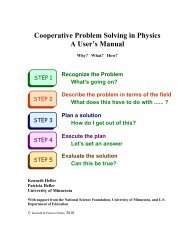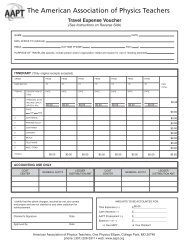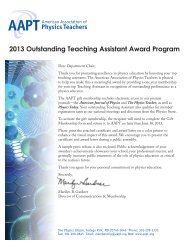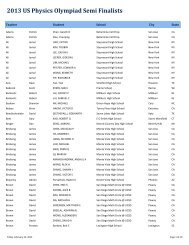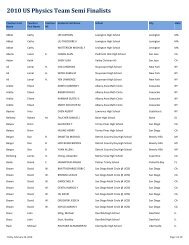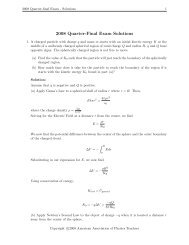Solution - American Association of Physics Teachers
Solution - American Association of Physics Teachers
Solution - American Association of Physics Teachers
Create successful ePaper yourself
Turn your PDF publications into a flip-book with our unique Google optimized e-Paper software.
2013 F = ma Exam 21. An observer stands on the side <strong>of</strong> the front <strong>of</strong> a stationary train. When the train starts moving with constantacceleration, it takes 5 seconds for the first car to pass the observer. How long will it take for the 10th car to pass?(A) 1.07s(B) 0.98s(C) 0.91s(D) 0.86s(E) 0.81s<strong>Solution</strong>Start with∆x = 1 2 at2 + v i tWe have four times. t 0 = 0 is when the train starts, and when the first car is aligned with the observer. t 1 iswhen the end <strong>of</strong> the first car is aligned with the observer. ThenL = 1 2 at 1 2We are assuming the car has a length L. t 2 is when the tenth car is first aligned with the observer, so9L = 1 2 at 2 2and finally, t 3 is when that car has passed,10L = 1 2 at 3 2From the equation for t 1 we findsoand2L/a = 25 s 2t 2 = √ 9 · 25 s 2 = 15 st 3 = √ 10 · 25 s 2 = 15.81 sCopyright c○2013 <strong>American</strong> <strong>Association</strong> <strong>of</strong> <strong>Physics</strong> <strong>Teachers</strong>
2013 F = ma Exam 32. Jordi stands 20 m from a wall and Diego stands 10 m from the same wall. Jordi throws a ball at an angle <strong>of</strong> 30 ◦above the horizontal, and it collides elastically with the wall. How fast does Jordi need to throw the ball so thatDiego will catch it? Consider Jordi and Diego to be the same height, and both are on the same perpendicular linefrom the wall.(A) 11 m/s(B) 15 m/s(C) 19 m/s(D) 30 m/s(E) 35 m/s<strong>Solution</strong>The wall acts like a mirror for a perfectly elastic collision. In that case, Jordi and Diego are effectively 30meters apart. Using the range formula,we getv 2 =R = v2gsin 2θ,gRsin 2θ ≈ 300 m2 /s 2√3/2v ≈ 19 m/sCopyright c○2013 <strong>American</strong> <strong>Association</strong> <strong>of</strong> <strong>Physics</strong> <strong>Teachers</strong>
2013 F = ma Exam 43. Tom throws a football to Wes, who is a distance l away. Tom can control the time <strong>of</strong> flight t <strong>of</strong> the ball by choosingany speed up to v max and any launch angle between 0 ◦ and 90 ◦ . Ignore air resistance and assume Tom and Wesare at the same height. Which <strong>of</strong> the following statements is incorrect?(A) If v max < √ gl, the ball cannot reach Wes at all.(B) Assuming the ball can reach Wes, as v max increases with l held fixed, the minimum value <strong>of</strong> t decreases.(C) Assuming the ball can reach Wes, as v max increases with l held fixed, the maximum value <strong>of</strong> t increases.(D) Assuming the ball can reach Wes, as l increases with v max held fixed, the minimum value <strong>of</strong> t increases.(E) Assuming the ball can reach Wes, as l increases with v max held fixed, the maximum value <strong>of</strong> t increases.<strong>Solution</strong>The greater the initial vertical velocity <strong>of</strong> the football, the longer it will take to fall back to the ground.Meanwhile, the initial horizontal velocity <strong>of</strong> the football increases with l and decreases with the time <strong>of</strong> flight.Thus the minimum time <strong>of</strong> flight is obtained by the minimum possible initial vertical velocity; it is limitedby the increasing required horizontal velocity, and this limitation becomes more severe as l increases. Themaximum time <strong>of</strong> flight is obtained by the maximum possible initial vertical velocity; it is limited by therequired horizontal velocity component, and this limitation likewise becomes more severe as l increases. Thusincreasing v max expands the range <strong>of</strong> available time <strong>of</strong> flight in both directions; increasing l contracts it inboth directions.(A) follows from the standard result for the maximum range <strong>of</strong> a projectile.For those who prefer the mathematical approach, we have for a launch angle θ and initial speed v 0Since sin 2 θ + cos 2 θ = 1,v 0 2 =2v 0 sin θ = gt(v 0 cos θ)t = l( ) 2 ( 2gt l+2 t)g 24 t4 − v 0 2 t 2 + l 2 = 0t 2 = 2 v 0 2 ± √ v 04 − g 2 l 2g 2(A) follows immediately from the requirement that the result be real. It is also clear that increasing l contractsthe range <strong>of</strong> available times in both directions, and that increasing v max increases the maximum availabletime. As for the minimum available time, we havet − 2 = 2 v 0 2 − √ v 04 − g 2 l 2g 2∂ ( t ) ()2 −∂ (v 02 ) = 2 22v 0g 2 1 −2 √ v 04 − g 2 l 2∂ ( t ) ⎛2 −∂ (v 02 ) = 2 ⎝1g 2 −1√1 − g2 l 2v 4 0The right hand side is always negative, so t − is always minimized by choosing the largest possible v 0 .⎞⎠Copyright c○2013 <strong>American</strong> <strong>Association</strong> <strong>of</strong> <strong>Physics</strong> <strong>Teachers</strong>
2013 F = ma Exam 7the graph we see that there are two periods <strong>of</strong> uniform acceleration; the first is downward with magnitude( )a = (10 m/s 2 60 kg) 1 − = 2.5 m/s 280 kgand the second is upward with the same magnitude. The maximum downward velocity occurs between theperiods <strong>of</strong> uniform acceleration, when the car travels at a constant speed; this occurs between 4 s and 22 s.The downward acceleration lasts for 2 s, so the speed <strong>of</strong> the elevator after the acceleration is 5 m/s. Theperiod between accelerations is approximately 20 s, and so the distance traveled is approximately 100 m. Infact, this calculation yields the exact answer, as can be seen by considering the exact graph <strong>of</strong> velocity vs.time:0−1Velocity (m/s)−2−3−4−50 2 4 6 8 10 12 14 16 18 20 22 24 26Time (s)The displacement is the area between the curve and the horizontal axis, which is exactly 100 m.7. A light car and a heavy truck have the same momentum. The truck weighs ten times as much as the car. How dotheir kinetic energies compare?(A) The truck’s kinetic energy is larger by a factor <strong>of</strong> 100(B) They truck’s kinetic energy is larger by a factor <strong>of</strong> 10(C) They have the same kinetic energy(D) The car’s kinetic energy is larger by a factor <strong>of</strong> 10(E) The car’s kinetic energy is larger by a factor <strong>of</strong> 100Express kinetic energy in terms <strong>of</strong> momentum,<strong>Solution</strong>Then the ratio isK = p22mK 1K 2= m 2m 1Copyright c○2013 <strong>American</strong> <strong>Association</strong> <strong>of</strong> <strong>Physics</strong> <strong>Teachers</strong>
2013 F = ma Exam 8The following information applies to questions 8 and 9A truck is initially moving at velocity v. The driver presses the brake in order to slow the truck to a stop. Thebrake applies a constant force F to the truck. The truck rolls a distance x before coming to a stop, and the timeit takes to stop is t.8. Which <strong>of</strong> the following expressions is equal the initial kinetic energy <strong>of</strong> the truck (i.e. the kinetic energy before thedriver starts braking)?(A) F x(B) F vt(C) F xt(D) F t(E) Both (a) and (b) are correct<strong>Solution</strong>Considering magnitudes only,K i = δK = W = F x9. Which <strong>of</strong> the following expressions is equal the initial momentum <strong>of</strong> the truck (i.e. the momentum before the driverstarts braking)?(A) F x(B) F t/2(C) F xt(D) 2F t(E) 2F x/v<strong>Solution</strong>Considering magnitudes only,butsop i = ∆p = F tx = 1 2 at2 = 1 2 (at)t = 1 2 vtp i = 2F x/vCopyright c○2013 <strong>American</strong> <strong>Association</strong> <strong>of</strong> <strong>Physics</strong> <strong>Teachers</strong>
2013 F = ma Exam 910. Which <strong>of</strong> the following can be used to distinguish a solid ball from a hollow sphere <strong>of</strong> the same radius and mass?(A) Measurements <strong>of</strong> the orbit <strong>of</strong> a test mass around the object.(B) Measurements <strong>of</strong> the time it takes the object to roll down an inclined plane.(C) Measurements <strong>of</strong> the tidal forces applied by the object to a liquid body.(D) Measurements <strong>of</strong> the behavior <strong>of</strong> the object as it floats in water.(E) Measurements <strong>of</strong> the force applied to the object by a uniform gravitational field.<strong>Solution</strong>The measurement described in (B) is certainly appropriate; the solid ball has a smaller moment <strong>of</strong> inertiathan the hollow sphere and will accelerate down the inclined plane faster.The measurements in (A) and (C) are unhelpful because they only probe the gravitational field outside theobject; for a spherically symmetric object this depends only on the mass. The force measured in (E) dependsonly on the object’s total mass; the buoyant force applied in (D) depends only on the external shape <strong>of</strong> theobject.Copyright c○2013 <strong>American</strong> <strong>Association</strong> <strong>of</strong> <strong>Physics</strong> <strong>Teachers</strong>
2013 F = ma Exam 1011. A right-triangular wooden block <strong>of</strong> mass M is at rest on a table, as shown in figure. Two smaller wooden cubes,both with mass m, initially rest on the two sides <strong>of</strong> the larger block. As all contact surfaces are frictionless, thesmaller cubes start sliding down the larger block while the block remains at rest. What is the normal force fromthe system to the table?m90mαMβ(A) 2mg(B) 2mg + Mg(C) mg + Mg(D) Mg + mg(sin α + sin β)(E) Mg + mg(cos α + cos β)<strong>Solution</strong>Two forces act on each cube: the normal force from the triangular block, and gravity. The normal force mustbalance the normal component <strong>of</strong> gravity, which in the case <strong>of</strong> the left cube isF N = mg cos αThe vertical component <strong>of</strong> this normal force is transmitted through the triangular block to the ground, andisF Ny = mg cos 2 αA similar result holds for the other cube, and in addition the ground must support the weight <strong>of</strong> the triangularblock; thus in totalF tot = mg cos 2 α + mg cos 2 β + MgHowever, because the block is a right triangle, cos 2 α + cos 2 β = 1, so thatF tot = mg + MgNote that the horizontal component <strong>of</strong> the normal force due to the left cube isF Nx = mg cos α sin αThe right cube likewise applies a normal force with horizontal component mg cos β sin β in the other direction.But, once again, because the block is a right triangle, cos α sin α = cos β sin β, so the net horizontal force iszero! This justifies the given assumption that the triangular block does not slide on the table.Copyright c○2013 <strong>American</strong> <strong>Association</strong> <strong>of</strong> <strong>Physics</strong> <strong>Teachers</strong>
2013 F = ma Exam 1112. A spherical shell <strong>of</strong> mass M and radius R is completely filled with a frictionless fluid, also <strong>of</strong> mass M. It is releasedfrom rest, and then it rolls without slipping down an incline that makes an angle θ with the horizontal. What willbe the acceleration <strong>of</strong> the shell down the incline just after it is released? Assume the acceleration <strong>of</strong> free fall is g.The moment <strong>of</strong> inertia <strong>of</strong> a thin shell <strong>of</strong> radius r and mass m about the center <strong>of</strong> mass is I = 2 3 mr2 ; the moment<strong>of</strong> inertia <strong>of</strong> a solid sphere <strong>of</strong> radius r and mass m about the center <strong>of</strong> mass is I = 2 5 mr2 .(A) a = g sin θ(B) a = 3 4 g sin θ(C) a = 1 2 g sin θ(D) a = 3 8 g sin θ(E) a = 3 5 g sin θOne can use torque or energy to solve this problem.<strong>Solution</strong>The torque about an axis through the point <strong>of</strong> contact isThe angular acceleration is given bywhere the moment <strong>of</strong> inertia isThe acceleration is thenτ = RF sin θ = 2MgR sin θτ = IαI = 2 3 MR2 + MR 2 + MR 2 = 8 3 MR2a = αR =Alternatively, the kinetic energy <strong>of</strong> the object is2MgR sin θ83 MR2 R = 3 4 g sin θT = 1 2 (2M)v2 + 1 2 · 23 MR2 ω 2T = 4 3 Mv2The potential energy is related to the vertical position y byU = −(2M)gyand so by conservation <strong>of</strong> energyButand sod(T + U) = 0dt8 dvdyMv = −(2M)g3 dt dtdydt= −v sin θdvdt = 3 4 g sin θCopyright c○2013 <strong>American</strong> <strong>Association</strong> <strong>of</strong> <strong>Physics</strong> <strong>Teachers</strong>
2013 F = ma Exam 1213. There is a ring outside <strong>of</strong> Saturn. In order to distinguish if the ring is actually a part <strong>of</strong> Saturn or is instead part<strong>of</strong> the satellites <strong>of</strong> Saturn, we need to know the relation between the velocity v <strong>of</strong> each layer in the ring and thedistance R <strong>of</strong> the layer to the center <strong>of</strong> Saturn. Which <strong>of</strong> the following statements is correct?(A) If v ∝ R, then the layer is part <strong>of</strong> Saturn.(B) If v 2 ∝ R, then the layer is part <strong>of</strong> the satellites <strong>of</strong> Saturn.(C) If v ∝ 1/R, then the layer is part <strong>of</strong> Saturn.(D) If v 2 ∝ 1/R, then the layer is part <strong>of</strong> Saturn.(E) If v ∝ R 2 , then the layer is part <strong>of</strong> the satellites <strong>of</strong> Saturn.If attached to Saturn, then ω = v/R is a constant, so<strong>Solution</strong>v ∝ RIf in orbit, thenorv 2R = GMr 2 ,v 2 ∝ 1/R14. A cart <strong>of</strong> mass m moving at 12 m/s to the right collides elastically with a cart <strong>of</strong> mass 4.0 kg that is originallyat rest. After the collision, the cart <strong>of</strong> mass m moves to the left with a velocity <strong>of</strong> 6.0 m/s. Assuming an elasticcollision in one dimension only, what is the velocity <strong>of</strong> the center <strong>of</strong> mass (v cm ) <strong>of</strong> the two carts before the collision?(A) v cm = 2.0 m/s(B) v cm = 3.0 m/s(C) v cm = 6.0 m/s(D) v cm = 9.0 m/s(E) v cm = 18 m/s<strong>Solution</strong>In the center <strong>of</strong> mass frame, the carts initially have equal and opposite momenta, so that the total momentumis zero. After the elastic collision in this frame the momenta simply reverse direction; this clearly conservestotal energy and momentum. The frame <strong>of</strong> reference in which the velocity <strong>of</strong> the cart <strong>of</strong> mass m is reversedtravels to the right at 3 m/s, so that the initial velocity is 9 m/s to the right and the final velocity is 9 m/sto the left.Note that the mass and initial velocity <strong>of</strong> the other cart are not required at all!Copyright c○2013 <strong>American</strong> <strong>Association</strong> <strong>of</strong> <strong>Physics</strong> <strong>Teachers</strong>
2013 F = ma Exam 1315. A uniform rod is partially in water with one end suspended, as shown in figure. The density <strong>of</strong> the rod is 5/9 that<strong>of</strong> water. At equilibrium, what portion <strong>of</strong> the rod is above water?0000000000000000011111111111111111000000000000000001111111111111111100000000000000000111111111111111110000000000000000011111111111111111000000000000000001111111111111111100000000000000000111111111111111110000000000000000011111111111111111000000000000000001111111111111111100000000000000000111111111111111110000000000000000011111111111111111(A) 0.25(B) 0.33(C) 0.5(D) 0.67(E) 0.75<strong>Solution</strong>Suppose a fraction α <strong>of</strong> the rod is above water. Let the length <strong>of</strong> the rod be l, the volume <strong>of</strong> the rod be V ,the density <strong>of</strong> water be ρ w , and the density <strong>of</strong> the rod be ρ r . Consider torques about the pivot point. Gravityapplies a torqueτ g = ρ r V g · 12 lA fraction 1−α <strong>of</strong> the rod is submerged, and the center <strong>of</strong> the submerged portion is a distance (α+ 1 2 (1−α))lfrom the pivot. So the buoyant force applies a torqueτ b = ρ w (1 − α)V g ·(α + 1 )2 (1 − α) lThese torques must balance:τ b = 1 2 ρ w(1 − α 2 )V glτ g = τ b12 ρ r = 1 2 ρ w(1 − α 2 )ρ rρ w= 1 − α 2We are given ρrρ w= 5 9 , so that 59 = 1 − α2α = 2 3Copyright c○2013 <strong>American</strong> <strong>Association</strong> <strong>of</strong> <strong>Physics</strong> <strong>Teachers</strong>
2013 F = ma Exam 1416. Inspired by a problem from the 2012 International <strong>Physics</strong> Olympiad, Estonia.A very large number <strong>of</strong> small particles forms a spherical cloud. Initially they are at rest, have uniform mass densityper unit volume ρ 0 , and occupy a region <strong>of</strong> radius r 0 . The cloud collapses due to gravitation; the particles do notinteract with each other in any other way.√3πHow much time passes until the cloud collapses fully? (The constant 0.5427 is actually32 .)(A)0.5427r 02 √ Gρ 0(B)0.5427r 0√ Gρ0(C)0.5427√ r0√ Gρ0(D) 0.5427 √ Gρ0(E) 0.5427 √ Gρ0r 0<strong>Solution</strong>This problem is a matter <strong>of</strong> dimensional analysis. All <strong>of</strong> the answers have the formt = 0.527G −1/2 ρ −1/20 r 0nThe dimensions <strong>of</strong> t are [T ], the dimensions <strong>of</strong> G are [L] 3 [M] −1 [T ] −2 , the dimensions <strong>of</strong> ρ 0 are [L] −3 [M], andthe dimensions <strong>of</strong> r 0 are [L]. So[T ] = ([L] 3 [M] −1 [T ] −2 ) −1/2 ([L] −3 [M]) −1/2 [L] n[T ] = [T ][L] nn = 0The time to collapse does not depend on the size <strong>of</strong> the cloud at all!Copyright c○2013 <strong>American</strong> <strong>Association</strong> <strong>of</strong> <strong>Physics</strong> <strong>Teachers</strong>
2013 F = ma Exam 1517. Two small, equal masses are attached by a lightweight rod. This object orbits a planet; the length <strong>of</strong> the rod issmaller than the radius <strong>of</strong> the orbit, but not negligible. The rod rotates about its axis in such a way that it remainsvertical with respect to the planet.• Is there a force in the rod? If so, is it tension or compression?• Is the equilibrium stable, unstable, or neutral with respect to a small perturbation in the angle <strong>of</strong> therod? (Assume this perturbation maintains the rate <strong>of</strong> rotation, so that in the co-rotating frame the rodis still stationary but at an angle to the vertical.)(A) There is no force in the rod; the equilibrium is neutral.(B) The rod is in tension; the equilibrium is stable.(C) The rod is in compression; the equilibrium is stable.(D) The rod is in tension; the equilibrium is unstable.(E) The rod is in compression; the equilibrium is unstable.<strong>Solution</strong>Because the gravitational force goes as 1/r 2 , the inward force on the inner mass is greater than the inwardforce on the outer mass. On the other hand, both masses have the same angular velocity, so the centripetalacceleration goes as r, and the outer mass must be subject to a greater centripetal force than the inward one.So the rod must exert an inward force on the outer mass and an outward force on the inner mass. Thus therod is in tension.The stability <strong>of</strong> the position is best understood in the corotating frame. In this frame the outer massexperiences an outward radial force and the inward tension <strong>of</strong> the rod, and the inner mass experiences aninward radial force and the outward tension <strong>of</strong> the rod. When the rod is rotated slightly these forces createa restoring torque, so the equilibrium is stable.Copyright c○2013 <strong>American</strong> <strong>Association</strong> <strong>of</strong> <strong>Physics</strong> <strong>Teachers</strong>
2013 F = ma Exam 1618. Two point particles, each <strong>of</strong> mass 1 kg, begin in the state shown below.3y (m)210−1−21.0 m/s1.0 m/s−3−3 −2 −1 0 1 2 3x (m)The system evolves through internal forces only. Which <strong>of</strong> the following could be the state after some time haspassed?33(A)y (m)210−11.0 m/s1.0 m/s(B)y (m)210−12.0 m/s−2−2−3−3 −2 −1 0 1 2 332x (m)−3−3 −2 −1 0 1 2 332x (m)1.0 m/s(C)y (m)10−1−21.0 m/s1.0 m/s(D)y (m)10−1−21.0 m/s−3−3 −2 −1 0 1 2 33x (m)−3−3 −2 −1 0 1 2 3x (m)211.0 m/s(E)y (m)0−1−21.0 m/s−3−3 −2 −1 0 1 2 3x (m)<strong>Solution</strong>First, linear momentum is conserved; as it happens, the system begins with zero linear momentum. Thiseliminates choice (B).Copyright c○2013 <strong>American</strong> <strong>Association</strong> <strong>of</strong> <strong>Physics</strong> <strong>Teachers</strong>
2013 F = ma Exam 17Angular momentum about any point is also conserved. (It is specified that the particles are point particlesto rule out their having spin angular momentum.) As it happens, the system has zero linear momentum, sothe angular momentum is the same measured about any point; otherwise it would suffice to consider any onepoint. The total angular momentum must be 2 kg m 2 /s counterclockwise. This eliminates choices (C) and(D).Finally, because the linear momentum <strong>of</strong> the system is zero, the center <strong>of</strong> mass does not move. This eliminateschoice (A).The following information applies to questions 19, 20, and 21.A simple pendulum experiment is constructed from a point mass m attached to a pivot by a massless rod <strong>of</strong> lengthL in a constant gravitational field. The rod is released from an angle θ 0 < π/2 at rest and the period <strong>of</strong> motion isfound to be T 0 . Ignore air resistance and friction.19. At what angle θ g during the swing is the tension in the rod the greatest?(A) The tension is the greatest at the point θ g = θ 0 .(B) The tension is the greatest at the point θ g = 0.(C) The tension is the greatest at an angle θ g with 0 < θ g < θ 0 .(D) The tension is constant.(E) None <strong>of</strong> the above is true for all values <strong>of</strong> θ 0 with 0 < θ 0 < π/2.20. What is the maximum value <strong>of</strong> the tension in the rod?(A) mg(B) 2mg(C) mLθ 0 /T 02(D) mg sin θ 0(E) mg(3 − 2 cos θ 0 )21. The experiment is repeated with a new pendulum with a rod <strong>of</strong> length 4L, using the same angle θ 0 , and the period<strong>of</strong> motion is found to be T . Which <strong>of</strong> the following statements is correct?(A) T = 2T 0 regardless <strong>of</strong> the value <strong>of</strong> θ 0 .(B) T > 2T 0 with T ≈ 2T 0 if θ 0 ≪ 1.(C) T < 2T 0 with T ≈ 2T 0 if θ 0 ≪ 1.(D) T > 2T 0 for some values <strong>of</strong> θ 0 and T < 2T 0 for other values <strong>of</strong> θ 0 .(E) T 0 and T are undefined because the motion is not periodic unless θ 0 ≪ 1.<strong>Solution</strong>The mass accelerates towards the pivot due to centripetal acceleration; if its speed is v, this acceleration isa c = v2LTwo forces act in the radial direction; the tension in the rod, inward, and the radial component <strong>of</strong> gravity,outward. At an angle θ to the vertical the radial component <strong>of</strong> gravity isF g,rad = mg cos θFrom Newton’s second law we thus have for the tension FF − F g,rad = ma cCopyright c○2013 <strong>American</strong> <strong>Association</strong> <strong>of</strong> <strong>Physics</strong> <strong>Teachers</strong>
2013 F = ma Exam 18F = mg cos θ + m v2LBoth terms increase as the mass approaches the bottom <strong>of</strong> the swing, so the maximum tension certainlyoccurs there. At that point the mass has traveled a vertical distance L(1 − cos θ 0 ), so from conservation <strong>of</strong>energy12 mv2 = mgL(1 − cos θ 0 )and so at the bottomF = mg + 2mg(1 − cos θ 0 )F = mg(3 − 2 cos θ 0 )The motion is certainly periodic (one argument considers the fact that energy is conserved and the particleeventually returns to rest). From dimensional analysis the period must take the form√T = f(θ 0 )l 0gTherefore, for any fixed θ 0 , the period goes as √ l 0 .22. A simplified model on the foot is shown. When a student <strong>of</strong> mass m = 60 kg stands on a single toe, the tension Tin the Achilles Tendon is closest toLeg BoneAchillesTendonAnkle JointApproximation <strong>of</strong> Foot BoneOutline <strong>of</strong> FootToe0 4 8 12 16 20 24 28 32 36 40Centimeter Rule(A) T = 600 N(B) T = 1200 N(C) T = 1800 N(D) T = 2400 N(E) T = 3000 N<strong>Solution</strong>The entire weight <strong>of</strong> the student, W = mg = 600 N, is supported by the toe. Balancing torques about theankle,T · 5 cm = 600 N · 20 cmT = 2400 NCopyright c○2013 <strong>American</strong> <strong>Association</strong> <strong>of</strong> <strong>Physics</strong> <strong>Teachers</strong>
2013 F = ma Exam 19The following information applies to questions 23 and 24A man with mass m jumps <strong>of</strong>f <strong>of</strong> a high bridge with a bungee cord attached to his ankles. The man falls througha maximum distance H at which point the bungee cord brings him to a momentary rest before he bounces backup. The bungee cord is perfectly elastic, obeying Hooke’s force law with a spring constant k, and stretches froman original length <strong>of</strong> L 0 to a final length L = L 0 + h. The maximum tension in the Bungee cord is four times theweight <strong>of</strong> the man.23. Determine the spring constant k.(A) k = mgh(B) k = 2mgh(C) k = mgH(D) k = 4mgH(E) k = 8mgH24. Find the maximum extension <strong>of</strong> the bungee cord h.(A) h = 1 2 H(B) h = 1 4 H(C) h = 1 5 H(D) h = 2 5 H(E) h = 1 8 H<strong>Solution</strong>At the moment <strong>of</strong> maximum extension, all <strong>of</strong> the gravitational potential energy has been converted to springpotential energy.mgH = 1 2 kh2We are given that the maximum tension in the cord is four times the weight <strong>of</strong> the man; this occurs at themoment <strong>of</strong> maximum extension.kh = 4mgThese can be solved to yieldk = 8mgHh = 1 2 Has well ask = 4mghalthough the latter is not an available answer choice.Copyright c○2013 <strong>American</strong> <strong>Association</strong> <strong>of</strong> <strong>Physics</strong> <strong>Teachers</strong>
2013 F = ma Exam 2025. A box with weight W will slide down a 30 ◦ incline at constant speed under the influence <strong>of</strong> gravity and frictionalone. If instead a horizontal force P is applied to the box, the box can be made to move up the ramp at constantspeed. What is the magnitude <strong>of</strong> P ?(A) P = W/2(B) P = 2W/ √ 3(C) P = W(D) P = √ 3W(E) P = 2W<strong>Solution</strong>If block slides down at constant speed, thentan θ = µIf block is pushed by horizontal force P up ramp at constant speed, thenF N = mg cos θ + P sin θso friction isF f = µ(mg cos θ + P sin θ)This is balanced by gravity and the push up the ramp, soP cos θ = µ(mg cos θ + P sin θ) + mg sin θDivide through by cos θ, and use first equationP = µ(W + P µ) + W µororP = 2µ1 − µ 2 WP = 2 √ 1 31 − 1 W3Copyright c○2013 <strong>American</strong> <strong>Association</strong> <strong>of</strong> <strong>Physics</strong> <strong>Teachers</strong>





